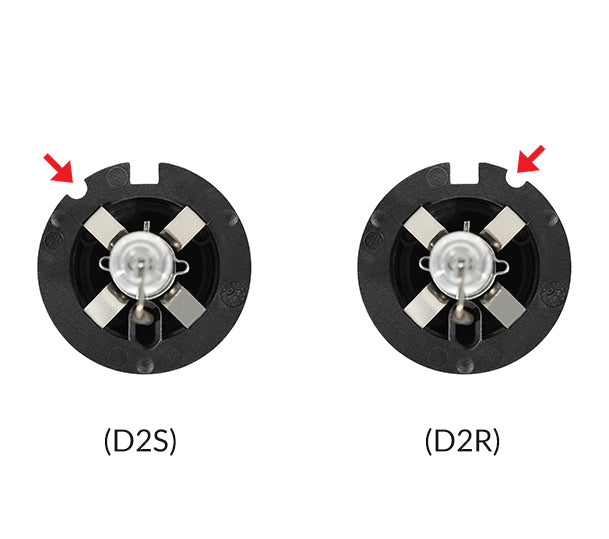Helpful Tech Tips and Tricks
WHEN THE HID BULB SIZE STARTS WITH 'D'
What is it?
HID Xenon headlights debuted on the BMW 7 series in 1992. The system used an unshielded, non-replaceable burner. This type of bulbs does not have a filament of any kind unlike halogens. It passes a very high voltage electric arc in between two contacts. Inside the glass chamber is a mixture of gases including Xenon, Argon and vaporized metals like mercury and metal halides. The arc in fact melts the metal vapors and turns them into plasma.
OEM (factory installed) HID headlights have a D-series naming system. They are named using 3 characters, like ‘D4R’, ‘D1S’, where: 'D' means ‘Discharge’, number (1,2,3,4) is the type and the last letter is used to determine what kind of application the bulb is meant to be.

The bulbs with ‘R’ (D1R, D2R, D3R, D4R) have an opaque shield that covers parts of the bulb. These lights are designed for use in a specifically designed reflector headlamp optics.
The ‘S’ type (D1S, D2S, D3S, D4S) does not have that kind of shield because they should be used in projector optics. It tends to have 300-400 more lumens than its ‘R’ counterparts.
These HID's of 'D' series always have a quartz envelope and arc positioned in the same place. They do not run on low-voltage DC current, but require ballasts with external or internal igniters that convert the power into AC and make a high voltage pulse to produce a spark.
What do their types mean?
First there were D1R and D1S. Automobile manufactures like Audi, Ford and Mercedes Benz have been using Xenon headlights starting from 1990’s. These lights have igniters that are built in the bulb base.


After that came D2 light type series. These headlights do not have igniters integrated into the base so that the bulbs are much smaller.
D1 and D2 types of light bulbs operate on 35W 85V AC current. These bulbs contain heavy metal mercury.
Newer HID bulb designs (D3S, D3R, D4S, D4R) that are in production since 2009 contain no mercury and are more environmentally friendly. These lights require special ballasts that differ from D1 and D2 types. The D3 lights come with built-in igniters.


The D4 headlight bulbs are smaller and require external igniters like D2 type. They are not that popular since most higher performance projectors are for D2 base.
These lights are not physically or electrically compatible with the headlight housings that are designed for previous bulb types. D3 and D4 lights operate on 35W 42V AC current.
What is the difference?
You can differentiate D1 and D3 bulbs comparing connectors of the ignitors. The D1 type has a keying on the top left corner of it, while the D3 on the left low corner.


You can tell the difference between D2 and D4 lights looking at the bulb base.


Aftermarket D1, D2, D3 and D4 bulbs have the letter C in the end and come with 5 notches. This means that they have the same bulb base which can fit all the types of the headlight housing though you should pay attention to the fact that the lights still differ according to their characteristics.

D1 and D3, D2 and D4 bulbs cannot be interchanged unless their ballasts and ignitors are replaced with the corresponding bulbs. You cannot mix components from 2 systems together.
Before letting you leave the page, let us make a few things clear:
- The D1 bulb type cannot be interchanged with the D3 and vice versa.
- You cannot replace the D2 bulb with the D4 and vice versa.
- The D1 and D2 bulbs contain mercury while D3 and D4 bulbs are mercury-free.